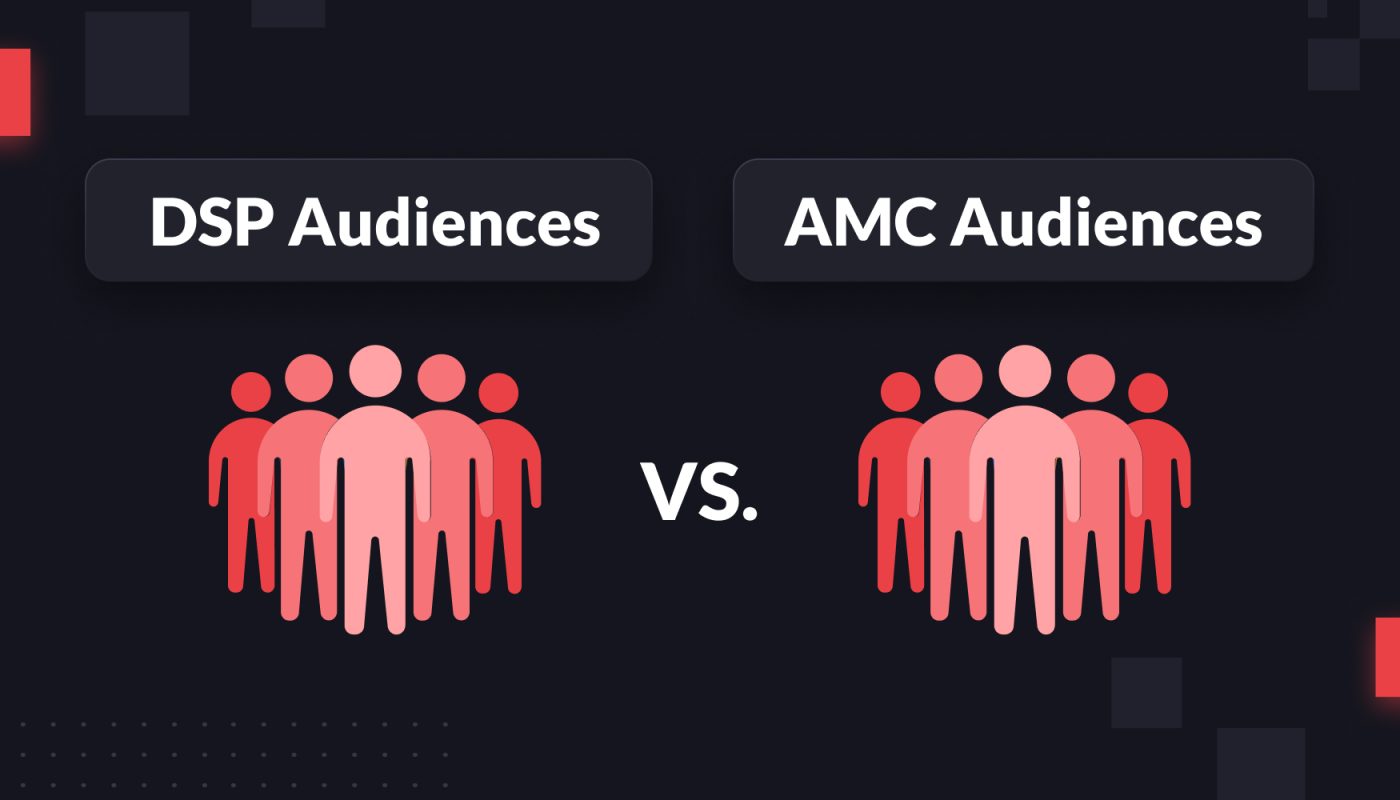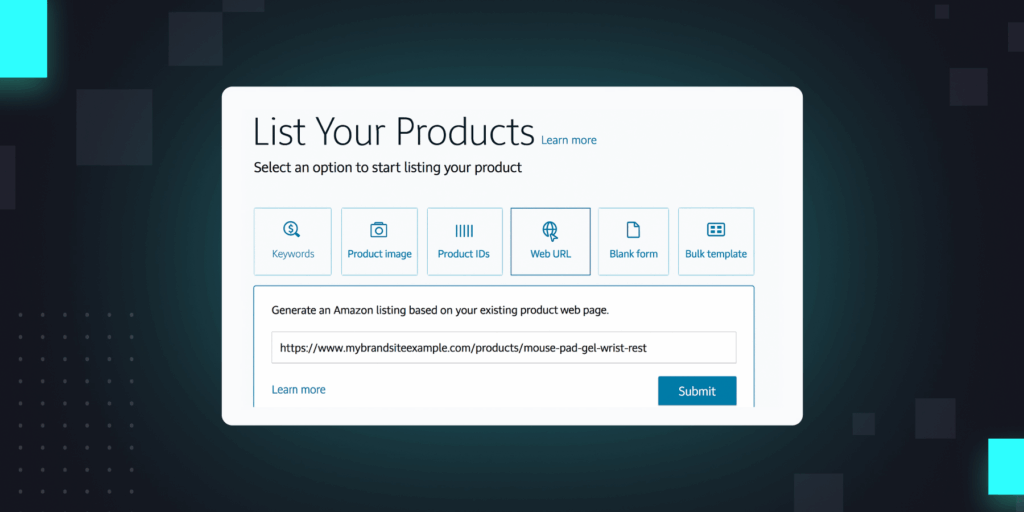Newcomers to Amazon DSP will be pretty quickly impressed by the level of granularity of DSP audiences.
In addition to the audiences that Amazon creates for you, such as Lifestyle audiences, Amazon lets you make your own audiences from scratch. Through the Amazon DSP Audience Builder, you can create audiences of shoppers based on categories like:
- View or purchase audiences, meaning people who viewed or purchased your product or your competitor’s product.
- Custom audiences, where you can create a group of shoppers who look similar to either (1) your existing shoppers or (2) your competitor’s shoppers. You can also upload your 1P data, and create a lookalike audience based on shopper emails.
These are all powerful targeting capabilities. All told, they’re a reason why we often say that DSP ads don’t have to be top-of-funnel. With Amazon DSP, you can get as specific or as general as you need.
But DSP built audiences have a number of important limitations—limitations that you can only get around by first creating a custom audience in Amazon Marketing Cloud, and then pushing it to Amazon DSP.
So what is the difference between audience building capabilities in Amazon Marketing Cloud as opposed to Amazon DSP? What can you do with AMC that you can’t with Amazon DSP?
Let’s break it down.
Target shoppers based on new behaviors in AMC
When you create a custom audience in Amazon Marketing Cloud, you can run ads to shoppers based on behaviors that aren’t available to in DSP. For instance, with AMC, you can:
Go after add-to-cart or add-to-list shoppers. One of the simplest selling points of Amazon Marketing Cloud is that you can target shoppers who added a product to their cart or to a gift or wish list, but didn’t purchase.
These are powerful audiences that are very close to the point of sale—but you have no way to directly target them in the Amazon DSP Audience Builder.
Reach shoppers who searched for a specific keyword. Similarly, what if you want to go after shoppers who searched for your brand name or another keyword but didn’t end up purchasing?
Sure, you can run a Sponsored Ad in the search results for those keywords, but with Sponsored Ads, you’re always going to be jockeying for space. A well-placed DSP ad a few days after the search might be enough to draw the shopper to your product page, and score a conversion.
You can’t build audiences around specific keyword searches in DSP, but you can in Amazon Marketing Cloud.
Create audiences based on patterns of behavior. What if you want to reach a group of shoppers that has already had specific touchpoints with your brand? For instance, what if you want to reach people who have already seen 2 of your DSP ads?
Because Amazon Marketing Cloud is the only way to map out your shoppers’ path to purchase, it is also the only way to create audiences based on multiple touchpoints.
Build an audience based on any touchpoints imaginable—the ads they viewed, the product pages they clicked, or any combination thereof.
Go beyond the traditional targeting metrics altogether. Want to reach shoppers based on something other than what they’ve searched or which product pages they’ve viewed?
The Amazon Marketing Cloud paid subscription, Amazon Insights, includes an audience targeting tool called Audience Segment Insights. Audience Segment Insights essentially tells you new facts about Amazon’s default audiences, e.g. Lifestyle or In-Market audiences.
You can now see how many shoppers are included in those audiences, how many of them are your customers, and so on. It is especially useful for high-funnel campaigns.
For example, you might want to target people who are in the fictional lifestyle segment of “Pet Owners.” But, if you don’t have a huge budget, that audience is probably too broad for your campaign.
By using Audience Segment Insights, you might be able to realize that a portion of that broader “Lifestyle: Pet Owners” audience overlaps with another audience “In-Market: Pet Supplies.” You could use this insight to add the “In-Market” audience to your targeting.
Take this a step further by creating an audience of people who have purchased from your brand before, and run the same overlap analysis. If you find that somebody in your past purchaser’s audience is 4x more likely to also be “In-Market: Pet Supplies,” you should add that In-Market audience to your campaigns.
You can also get more granular from there. Add in other demographic info like household income, location, or life updates, like “Recently Moved” or “New Parents.”
Sort your audiences based on ad exposure
Another difference between AMC and DSP audiences is that AMC much more holistically lets you create—or negate—audiences based on their exposure to your ads.
You can’t set full frequency caps in DSP. Marketers are keen to set frequency caps because they don’t want to overexpose the same shopper to their ads too many times. If someone sees your ads 10x and still hasn’t converted, chances are, they probably won’t convert on the 11th try.
That’s why you need to be meticulous about negating audiences who’ve seen your ads too many times already. DSP lets you set frequency caps at a daily or hourly level, so you can be sure the same shopper doesn’t see an ad of yours, say, 4x in a day.
But if you want a lifetime frequency cap, you’ll need to use Amazon Marketing Cloud. Only in Amazon Marketing Cloud can you set much longer frequency caps.
Want to be sure the same shopper hasn’t been exposed to your ads 10x over the course of the year? Just create an audience of those shoppers in AMC, and negate them from your future DSP campaigns.
Reach shoppers who have never seen an ad from you. For as vast as Amazon is, sometimes it can feel like you’re going after the same shoppers, over and over again. What if you want to be sure you’re reaching shoppers who’ve never seen ads from you?
If you’re running a New-To-Brand campaign, for example, this totally fresh audience probably sounds appealing. This kind of campaign is impossible to execute with the DSP Audience Builder, but AMC lets you create audiences of non-ad-exposed shoppers.
AMC audiences lets you go further back in time
The other two big benefits of AMC audiences is that they let you reach further back in time than is possible in DSP.
Target shoppers who viewed your PDP more than 90 days ago. DSP does let you target ads to people who viewed your product page, but there’s a hard limit: The shopper had to view your product within the last 90 days.
Target purchasers from more than 365 days ago. DSP lets you re-target recent purchases of your product to either get them to re-purchase or send them an upsell. This works well if you sell a product like laundry detergent that customers tend to re-order every couple months.
But if you sell a product with a longer life cycle, like a mattress or even a shower towel, most of your shoppers probably won’t re-purchase until a year or two after the original purchase.
Only in AMC can you go back further than a year to re-target shoppers. In fact, AMC lets you go as far back as you have data available.
The catch, of course, is that you need to be sure you’re building historical data in the background in order to track shoppers further than a year back in time.
You should be sure you’ve activated your AMC instance today, even if you’re not sure that you want to use AMC. Let it run in the background, and start accruing historical data. (We can help, for free.)







